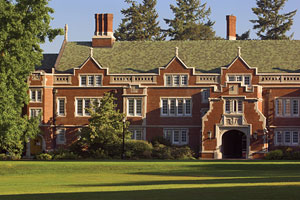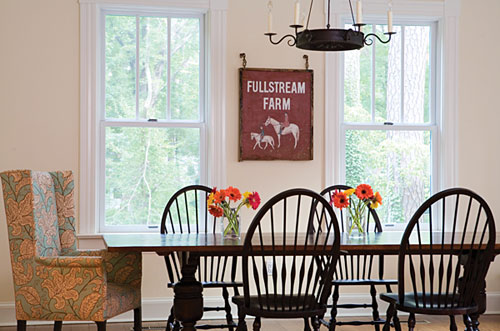Fiberglass Fenestration Comes into its Own
Stiffness. The high modulus of elasticity means fiberglass windows can withstand deformation or bending under load, which enables smooth operation over a long service life. Because it is strong and stiff, fiberglass is easy to install. Fiberglass windows remain square and level and resist warping and twisting during installation, a common problem during installation with other types of windows. It is extremely hard and thus highly scratch, dent and impact-resistant, and its strength is unaffected by time or temperature.
Fiberglass Windows for a Historic Renovation |
Reed College in Portland, Oregon, features Tudor-Gothic architecture and a forested canyon wilderness preserve at its center. When the school's Administration Building underwent a general upgrade and restoration, phase 1 included replacement of 200 windows. Pultruded fiberglass double-hung retrofit frames were installed. Because the requirements exceeded the usual height limitation for this line of windows, units were custom designed to match the historic references. The brick and granite fascia had to be equipped with dividers across the center of the middle and top story windows. On the interior, the clear vertical fir grain was easily matched with the existing finish. Fiberglass windows, which were also selected because of high energy efficiency and low environmental impact, replaced single-pane double-hung windows that had virtually no insulating value. The windows came with a ten-year commercial warranty. "This is an ideal product and a natural transition in the window industry to the next generation of products. It is a great looking window with many different configurations," noted General Contractor, Glenn Sheppard. |
 |
Custom-designed fiberglass replacement windows grace the campus of Reed College. Photo: Janis Miglavs |
Compatible thermal expansion. Because fiberglass frames are essentially glass fibers and resin, the frames expand and contract very little and at approximately the same rate as glass itself. If there is any expansion and contraction, the components expand and contract as a unit, unlike most window and door frames which have an interface of different materials: glass on wood, glass on aluminum or glass on vinyl. Aluminum is said to expand and contract three times as much as fiberglass and vinyl over seven times more. The minimal expansion and contraction of fiberglass puts less stress on the seals and frame-to-seal connection is maintained during temperature changes throughout the day and the seasons, thereby reducing the potential for air infiltration, a major cause of a building's loss of energy efficiency.
Natural insulation. Fiberglass is a superior insulator as it is made from a simple polymer reinforced with thin strands of pulled glass. Air is trapped inside, and it will not conduct heat or cold, so that its temperature should be neutral to the touch. Because the insulation of fiberglass is so effective, and because the temperature outside will not warm or cool the actual fiberglass in the window itself, excess condensation will not form. Fiberglass' high condensation resistance helps keep humidity within a suitable range and limits the growth of mold and mildew.
Low thermal transmittance. Fiberglass' low U-Value, the ultimate determinant of energy efficiency, helps lower building operating costs and increase occupant comfort. Filling the fiberglass frames with foam insulation and glazing the windows with high-efficiency insulating glass adds substantially to window performance and to energy-efficient window strategies including passive heating and cooling and maximum daylighting to dramatically cut energy load and increase occupant comfort.
Decorative options. Fiberglass is eminently paintable, and takes paint easily with excellent adhesion. Fiberglass can accommodate liquid coatings such as water- and solvent-based acrylic enamels and polyurethanes as well as dry powder coatings; alternatively, pigment can be added to the resin. With low conduction of heat, and the stability in fiberglass, it can also be painted in a variety of dark colors.
 |
Fiberglass windows are virtually maintenance free. Photo: Ron Blunt |









